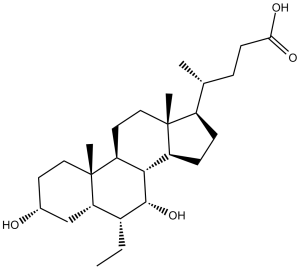This product is for research use only, not for human use. We do not sell to patients.

| Size | Price | Stock |
|---|---|---|
| 500mg | $500 | In Stock |
| 1g | $750 | In Stock |
| 5g | $1125 | In Stock |
Cat #: V1844 CAS #: 459789-99-2 Purity ≥ 98%
Description: Obeticholic Acid (INT747; 6-ECDCA; 6-Ethylchenodeoxycholic acid; trade name Ocaliva), a novel derivative of cholic acid, is a potent, orally bioactive and selective agonist of farnesoid X receptor (FXR) with EC50 of 99 nM, and has anticholeretic and anti-inflammatory activities.
Publications Citing InvivoChem Products
Product Promise

- Physicochemical and Storage Information
- Protocol
- Related Biological Data
- Stock Solution Preparation
- Quality Control Documentation
| Molecular Weight (MW) | 420.63 |
|---|---|
| Molecular Formula | C26H44O4 |
| CAS No. | 459789-99-2 |
| Storage | -20℃ for 3 years in powder formr |
| -80℃ for 2 years in solvent | |
| Solubility In Vitro | DMSO: 84 mg/mL (199.7 mM)r |
| Water: <1 mg/mLr | |
| Ethanol: 84 mg/mL (199.7 mM) | |
| SMILES Code | C[C@@H]([C@H]1CC[C@@]2([H])[C@]3([H])[C@H](O)[C@H](CC)[C@]4([H])C[C@H](O)CC[C@]4(C)[C@@]3([H])CC[C@]12C)CCC(O)=O |
| Synonyms | INT-747, 6-ECDCA; 6-Ethylchenodeoxycholic acid; Obeticholic acid; INT 747; INT747; Ocaliva. |
| Protocol | In Vitro | Obeticholic acid (INT-747) increases the expression of FXR-regulated genes in rat hepatocytes. |
|---|---|---|
| In Vivo | Obeticholic acid (INT-747) (10 mg/kg/day) completely reverted cholestasis induced by E217α. Administration of Obeticholic acid (INT-747) partially prevents the impairment in total bile acid output caused by E217α by increasing the relative abundance of β-MCA and TCDCA and TDCA. |
| Solvent volume to be added | Mass (the weight of a compound) | |||
|---|---|---|---|---|
| Mother liquor concentration | 1mg | 5mg | 10mg | 20mg |
| 1mM | 2.3774 mL | 11.8869 mL | 23.7739 mL | 47.5477 mL |
| 5mM | 0.4755 mL | 2.3774 mL | 4.7548 mL | 9.5095 mL |
| 10mM | 0.2377 mL | 1.1887 mL | 2.3774 mL | 4.7548 mL |
| 20mM | 0.1189 mL | 0.5943 mL | 1.1887 mL | 2.3774 mL |
This equation is commonly abbreviated as: C1 V1 = C2 V2
- (1) Please be sure that the solution is clear before the addition of next solvent. Dissolution methods like vortex, ultrasound or warming and heat may be used to aid dissolving.
- (2) Be sure to add the solvent(s) in order.




































